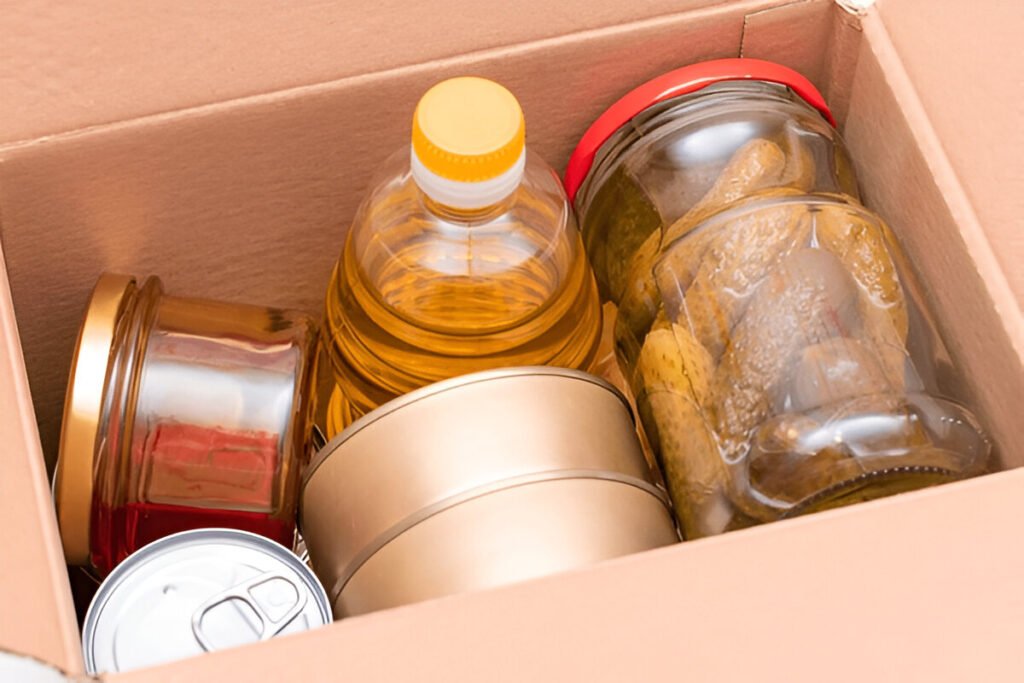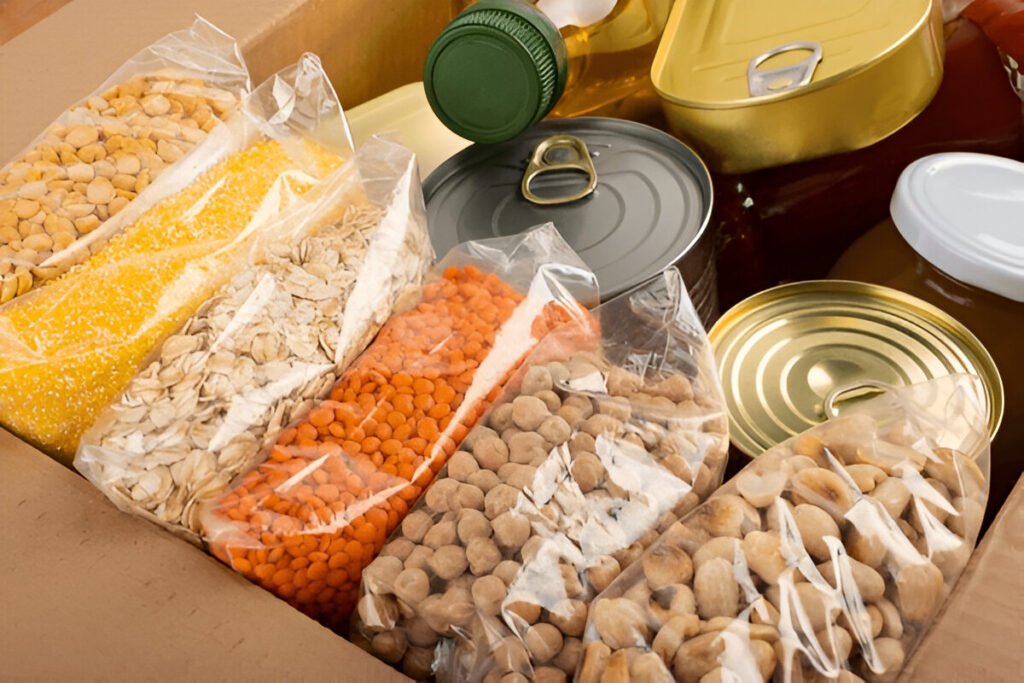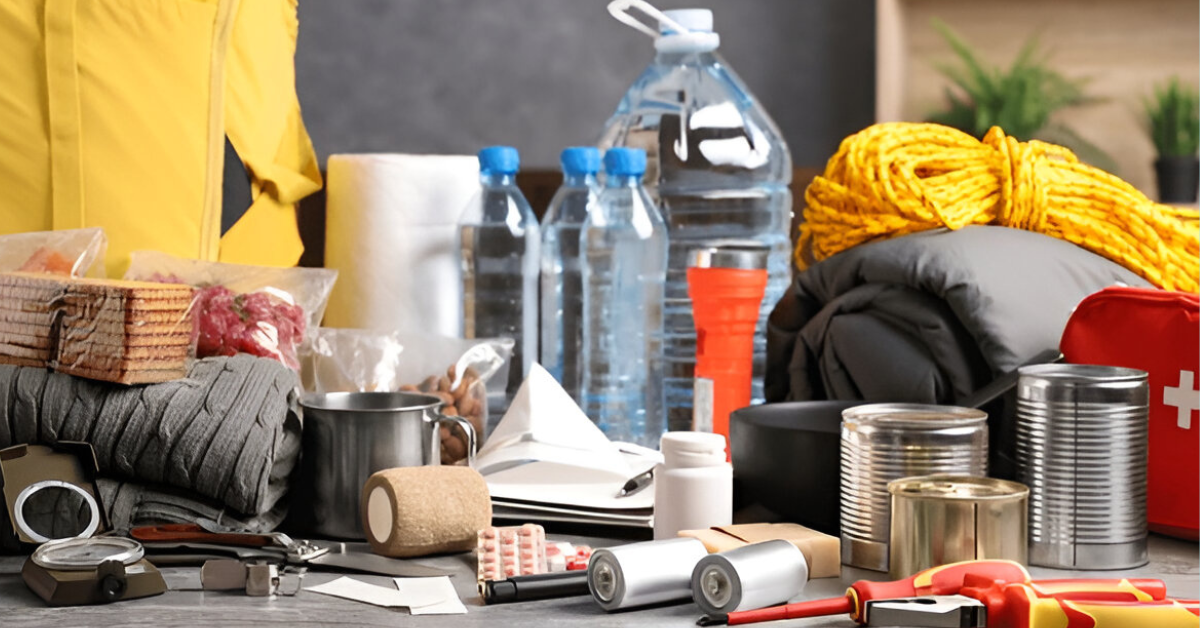But no one can predict when there will be an unfortunate event such as disasters, blackouts, or other similar calamities. An emergency food supply keeps its owner and family fed if usual food supplies are interrupted. In this guide, you will find all the basic facts and recommendations about emergency food storage, as well as what food to use, how much of it you should have, and how to keep it from going bad. Now, let’s get deeper into it to assist you in establishing durable emergency food storage.

Table of Contents
Why You Need Emergency Food Supplies
Disasters can be varied: natural disasters, including earthquakes, hurricanes, floods, blizzards, tornados, tsunamis, etc., and man-made disasters, including financial difficulties. Whenever people are locked indoors, moving outdoors is either limited or impossible, or a breakdown of retail supply chains occurs, having an emergency supply of food becomes dire.
Natural Disasters
This is because after the disaster, the roads may be closed, stores may shut, and the new food supply may take days or weeks to arrive. In such situations, you can starve until conditions get better; if you have some emergency food supplies, you may decrease your hunger time.
Weather Disruptions and Blackouts
While blackouts last, your refrigerated foods risk worsening, depriving you of fresh fruits, vegetables, meat, and dairy. Also, shortages like the current pandemic or cases like a strike by employees engaged in the production process make it a nightmare to restock some of these products. In such situations, having emergency storable foods that do not require refrigerator storage can be a godsend.
Personal Emergencies
Hunger is also caused by dramatic life events such as severe sickness or the loss of a source of income to enable one to buy food. As is often the life case, stocked emergency food supplies can make things much easier when you are otherwise down on your luck.
Types of Emergency Food Supplies
Not all the foods that can be eaten during an emergency are the same. Some are for long-term storage, while others are prepared quickly and can be eaten simultaneously. The first thing concerning preparedness is that you must create quality emergency food supplies, which should consist of different types of food for your convenience. Here are the main types to consider:
Non-Perishable Foods:
Staple foods are probably the easiest to store and are the life of any emergency food supply kit. These foods have a long shelf life and will not need refrigeration; they will be handy during emergencies. Popular non-perishable items include:
Canned goods: plants, cereals, animal products, salads, and setbacks.
Dried foods: carbohydrates—rice, beans, pasta, lentils, grains.
Powdered products: protein, carbohydrates, fats, milk, protein powder, powdered eggs.
Shelf-Stable Items
These products can remain long without being disposed of after being opened [Source 5 p. 54]. This can be sealed packages of crackers, cereals, nuts and seeds. Surprisingly, they are easy to prepare, and they offer quick energy.
Ready-to-Eat Meals (MREs)
MREs are short-term, ready-to-eat, fully prepared meals that can be eaten without cooking and are typically designed for the military, companions, travellers, or those on a trip. Originally, MREs were introduced to meet the US military’s needs; even now, such compositions are liked by survivalists as well as by those who travel by campers because they do not spoil for a long time and are easy to prepare themselves. These can include the main course dish, utensils, accompaniments such as salads and puddings, and dessert, and are discovered to have very long shelf lives provided they have been well stored.

How Much Food Should You Store?
In your emergency food supplies, the quantity depends on the number of people in your household, the duration of the emergency period, and special diets. As a rule of thumb, professionals suggest everyone should stock up on at least a three-day food supply. For prolonged emergencies, though, it is even more desirable to strive to provide at least two weeks’ worth of supply and more.
Assessing Family Size
The more people there are in a given household, the more food the household will require. For instance, if we apply the three-day-per-person rule of food storage, a family of four should set aside food for not less than 12 days.
Recommended Days of Supply
While three is the absolute minimum, all the survivalists will recommend that you prepare more than three days: at the very least, take a month’s supply or more if your area is vulnerable to hurricanes or blizzards.
Recalling Special Requirements for Diet
In households where someone is allergic to certain foods or is on a special diet like gluten-free, sodium-free, or vegan diets, there is a need to stock foods meeting these diets in the emergency food supplies. Others include infants suffering from special health conditions, old family members, or pets who may also need special foods.
Factors to Consider When Choosing Emergency Food Supplies
One must remember not to let go of quality foods because fruits and vegetables may appear tasty. Several factors will determine the shelf life, nutritional content, and practicality of the foods you store.
Refrigeration Shelf Life and Normal Storage Conditions
Another important factor to consider is whether the food will last long enough to reach the consumer or if the consumer will have to prepare it immediately after purchase. While some products maintain their emergency food shelf life for up to 25 years, others only last for a few months. otechno\=\enloond Products should ideally have a long shelf life, as they should be stocked properly in a cool and dry place.
Nutritional Value
Knowing that you may not be able to get your next meal for quite some time, you want to be assured that the food you’re eating is healthy for you. Select a diverse number of products containing carbohydrates, protein, and fats. Ensure they get their vitamins and minerals; canned vegetables and fruits are also good; if your pet needs supplements, speak with your veterinarian.
Conciseness in Preparation and Consumed Forms
In such circumstances, cooking utensils and clean water, in particular, might not be available, so select convenient foods to prepare and consume. Precooked, dehydrated, MRE canned foods, freeze-dried meals, and meals that require minor heating are ideal. Also, keep manual items such as a can opener, spoons, and forks.
Best Non-Perishable Foods for Emergencies
Of course, while constructing an emergency food supply, some categories of non-perishable foods are more efficient for long-term storage. Here’s a list of must-have items:
Canned vegetables and fruits: These are vital sources of vitamins, fibre, and water, and they should not be taken out of our diets. To be even healthier, opt for foods that have little or no sodium and no added sugars.
Canned Meat and Fish: There’s no need to explain it in detail because anyone knows that having tuna, chicken, salmon, beef and other types of meat in your survival diet is high in protein and can be kept for years in the tin cans.
Dried Foods: Potatoes, rice, beans, and lentils have heavy amounts of carbohydrates and protein and can be stored for many years in an airtight container.
Powdered Milk and Protein Powders: These are easy to store and, as commonly agreed, form a rich source of protein and calcium, two of the most vital nutrients for the body.
Freeze-Dried and Dehydrated Foods: A Long-Term Solution
If people are searching for something that will keep for extended periods without expiring, then freeze-dried and dehydrated foods are, without a doubt, the best choice. These foods can stay in storage for 25 years, depending on how you store them, and they are also light, making it easier to store a lot of them.
Advantages of freeze-dried foods
Now, frozen food is almost normal in most households since it passes on most of the nutrients and tastes, and its preparation method involves the removal of water. Because of this, they are very suitable for storage and mobility during emergencies, even in commercial vehicles.
Methods of Rehydration and Processing of These Foods
Freeze-drying means that most meals require a very simple preparation method: hot water is all needed. You must pour some water over your food and let it soften before gobbling it up. Such convenience is most advantageous if cooking is not an option at all.
MREs (Meals Ready-to-Eat)
Meals ready to eat are fully assembled meals that do not require rehydration or any cooking. It is very strong; they are made to endure dreadful environments, making them suitable for military personnel.
Advantages and Disadvantages of MREs
Benefits: Favorite features that make MREs increasingly popular include being hungry and needing to eat but not having a stove and no time to cook because each meal comes with a utensil and condiments. It is a fact that they can stay for a long time without spoiling and can be stocked for up to five years.
Drawbacks: They can be more costly than other forms of emergent foodstuff, and others may not appreciate the taste or texture of these foods as fresh or canned foods.
Food Storage Tips for Longevity
However, to increase the shelf life of the stored food, you need to store it correctly, as explained below.
Proper Storage Locations
Therefore, an ideal storage place for emergency food should be in a cool, dark and dry place. They are usually kept in basements, pantries or closets so they don’t attract attention. Do not leave food in areas likely to change temperatures, such as the attic or the garage.
Avoiding Spoilage
Ensure you also rotate your food with your different supplies to ensure that most of it does not get spoiled. Apply the “first come, first served” system—eat what you had bought earlier and replace those with new inventory. Make sure to label all of them to indicate when exactly you purchased them so they can know when they expire.
Sealing and Packaging
When storing foods that are not supposed to be moist, such as rice beans and pasta, one could store them in containers with airtight locks or vacuum-packed. They also make the goods take longer to become unsuitable for consumption, hence helping to increase the ratio of goods to be stored.

Emergency Food Supply Kits: What to Include
Emergency food supplies kits are available at many shops if you want to purchase a complete package. They may contain meals ready to eat in rehydration, water purification equipment, and other allied items.
What to Include in a DIY Kit
If you prefer to build your kit, here are some essential items to include:
It is a list of non-perishable foods: canned foods, dried foods, freeze-dried foods, etc.
Water purification pills or purification kits where you need to add chemicals to the water.
A manual can opener and tableware
First aid supplies
Some portable stoves or fire starters
DIY Emergency Food Supply: How to Build Your Own
Storing your own emergency food supplies can provide ultimate control concerning the types of food to store and how many servings you want to have on hand. Raw ingredients such as rice, pasta, and canned products should be transitioned to MREs, as well as freeze-dried foods and snacks.
Budget-Friendly Options
A calorie-rich list for those on a tight budget, rice, beans and oats can be bought in large quantities to feed many, and if well proportioned, the quantity is enough to provide enough calories. Canned food is generally suggested to be bought in large quantities; therefore, discount stores have canned foods that can be excellent emergency food supplies.
Organizing Your Storage
Using shelves or storage bins to sort your emergency food would be best. Items that go well together should be grouped together; for instance, canned foods should be in one area, dry foods in another, and healthy snacks in another area where they are well labelled with a date on when they expire.
Maintaining and Rotating Your Emergency Food Supply
The principle of trying to stock foods frequently and equally also helps prevent spoilt foods in your stores.
Some individuals may contemplate how to rotate the stock for freshness, and this article will guide them. Once every few months, take some time to inventory the items you have in storage, then take whatever is close to expiring and consume it. This way, try replacing them with new stock to ensure your supply is always on hand.
Tracking Expiration Dates
It will be wise to maintain a list or a spreadsheet of every food item you have considered taking as an emergency food item and their respective expiry dates. This makes monitoring what needs to be used or even disposed of possible.
Updating Your Food Supply
Learn from your family’s situation and remember to adjust the prepared food emergency stock depending on the family’s new needs. This is particularly so if you have growing kids or other family members with new dietary needs.
Water: A Crucial Component of Emergency Food Supplies
Drinkable water is as necessary as any food item in an emergency. However, no food can last long if there is no clean water to drink or cook with in case of any deficiency.
The amount of water storage per person is normally determined concerning the incidence and severity of water shortages.
Stocking up at least one gallon of drinking water per person per day is advised. This amount can be used for drinking, cooking and other purposes like washing.
Water Storage Tips
Water should be stored in food-grade containers and a well-shaded area. If you reside here and are out of your stored water, call water purification tablets or a portable filter to treat water.
Where to Buy Emergency Food Supplies
Emergency food supplies are available from a variety of sources:
Online Retailers
Amazon, ReadyWise, and Mountain House are among the companies selling a large range of emergency food supplies, including meals in different states: freeze-dried and MREs
Local Grocery Stores
All grocery stores have canned foods, packets of rice, beans, noodles and other general foods that are great for an emergency stash. Purchase when on offer to build a stock at a lesser price.
Specialty Retailers
Besides that, in sports shops that specialise in survival gear and climbing equipment, or simply any company that supplies products for the outdoors, food can be found for a longer period of time, for example, freeze-dried meals or emergency food kits.
Conclusion
In organising emergency preparedness(Emergency food supplies), food security during and after the disaster is critical for each family. If you provide your family with non-perishable foods, freeze-dried meals, and MREs properly stored and help them apply necessary storage techniques, they will definitely be prepared for any emergencies. Continuing to put new products on the shelves occasionally and replacing the products that run out when restocking is the best way to ensure everything is fresh and available when needed most.
FAQs
What is the lifespan of emergency food stocks?
The shelf-life of emergency food supplies may be as low as five years or up to twenty-five years, depending on the type of food and storage conditions. Freeze-dried meals and MREs are the longest among the meals one can receive.
What is the best way not to refrigerate or freeze?
Canned and other preserved products must not be stored in a refrigerator. These should be stored in cool, dry places and should be used on a first, first-in-first-out basis to avoid early spoilage.
How, then, should water be stored in preparation for its rushed use in the case of any breakout?
Finely store water in food-grade containers, and be sure that the water is well stored in a cool, dark area. Try to provide each individual with at least one gallon of water per day, and look at some of the water treatment methods on the market as a backup.
Are there ways that allow me to incorporate fresh foods into my emergency food stockpile?
Fresh products should not be stored in emergency supplies as they will easily go bad. However, when fresh foods are stored properly, you can keep a little stock of fresh foods with anyone – be it in the refrigerator or for short-term preservation.
Should I have a special ration for pets as people do?
Ah, yes, this sounds feasible because all pets need their food, and having a separate emergency stock feast for them is crucial. You must have adequate stock of food and water for your pet during a time of disaster.

